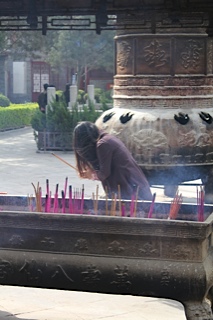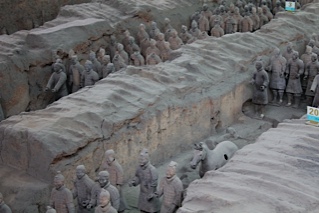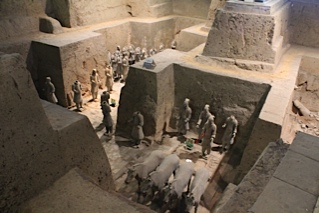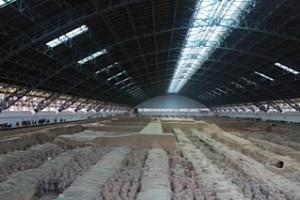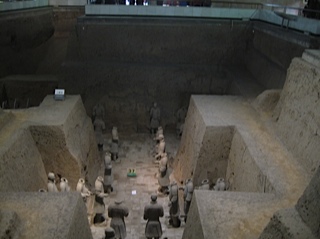
From Pit 2, this is probably headquarters for the army. Note they are all facing one another, and all of higher rank
The Terra Cotta Warriors outside of Xian represent the ultimate daoist ritual. They estimate over 7000 warriors, all built for the purpose of burning so that they would go to heaven with the emperor allowing him to have an army so he could rule the afterlife as he brought together and ruled China. Today, the Terra Cotta Warriors are a “must see” in China. From the same emperor who built the Great Wall, the Terra Cotta Warriors span an area of many football fields, with larger-than-life figures – all unique, and each one in perfect military order. Something for the tourist, novice historian, or anyone interested. If you think the Great Pyramids are interesting, this is larger, more impressive, and mysterious.
The first emperor of China, Emperor Qin the one who brought all six nations together unified the country, then named it after himself – China, built the Terra Cotta army. To understand why he built these figures is to understand a bit of Daoism, the religion of Qin, and the “traditional” religion of China. Going to a daoist temple today you will find people outside selling fake money, paper appliances, paper cell phones, paper houses. All of these items are brought to the temple and burned- where, the belief is, they go to the afterlife, so their ancestors can have money, cellphones, appliances, and almost anything to make their life comfortable.
Emperor Qin was obsessed with the afterlife, with immortality, and with his enemies. Having survived many assassination attempts, uprisings, and continued unrest from the states he conquered, his concern two-fold – first to rule the universe and second, to make certain he was protected from his enemies.According to some, some 700,000 workers made this army of terra cotta over 40 years. Each warrior is different, no two faces a like, and the warriors were placed in the order of their battlefield. Archers, longbow, infantry, cavalry, chariots all set up in perfect order, the order that they would go into battle. All soldiers armed with real weapons from bronze arrows to spears, axes, and crossbows.
Built, then arranged into the earth, they face the east- or the direction where Qin’s enemies were. Some flanking soldiers face other directions, just to keep a watch to not be out-flanked, but the vast majority of the army is facing east where his enemies were, where the nations were to conquer, and where he would go in the afterlife.

Recovered from a pit next to what we think is the Tomb of Qin, this was one of the horses thought to bring is soul to the next life
These were not built to be a memorial to the Emperor, but rather to be soldiers for him in the afterlife. Thus, they were built many miles away from the city, where only the workers knew – in an area occupied by cave dwellers. Not far from where Qin would have his tomb built, and set up to protect the emperor and his tomb.
Once arranged in proper order in a building partially dug into the clay covered with a roof made of wood. Once word of the Emperor’s death, the entire roof was set ablaze, a spectacular fire, and these facsimiles, the Terra Cotta Warriors, would become reality in the next life, providing the emperor both with protection from his enemies and an army to conquer the known world.
To the south of the warriors was a mountain, that provided the forest which provided the lumber for the roof, for the kilns, and for some of the pieces. This mountain was said to have been completely stripped of the forest.Imagine this large army, built in the middle of nowhere, then once the emperor died, the roof set afire so they could go, then abandoned. Much like ashes of a sacrifice, no reason to go back. As the rains came the mountain began to have avalanches, with no forest to hold the soil in place, and year after year these warriors were buried deeper and deeper. When you look at how they excavated the warriors you can see layer after layer of dirt, representing the avalanches from years ago – coming yearly until the mountain was re-forested.
It is said the workers on this project were killed and buried, some say that as a part of the Daoist ritual they simply left as this was a sacrifice, no longer of interest, no reason to see it more than someone would go back .

A sitting archer, and behind him the most famous Clarence Guo- who has written the book about the Qin Warriors
In 1974 some farmers were digging a well, and came across a the first Terra Cotta Warriors, now 8 meters below the surface, buried for over two thousand years. Soon the archaeologists’ came and this would be known as pit one- dug out for 230 meters east to west and 62 meters north to south, with around 6000 larger than life-size warriors and their horses. Soon two more pits were discovered, pit two is 20 meters north of the original pit and pit three is 120 meters east of that pit. All in all there are more than 7600 terra cotta warriors and horses. All of these about 50 km from where the emperors tomb is thought to be – and now with more than 400 pits around this area the thought is that Emperor Qin built a city!
We don’t know too much about what happened here- we do know that all the roofs were wooden, and that all burned at the same time – by carbon dating 2200 years ago (or the time of Qin’s death). One theory is that rebels came and burned the area, but, as Clarence Guo points out so well in his book, Guide to the Qin Warriors” – hard to believe that rebels would leave all the weapons they left, and that that the terra cotta soldiers are left in the condition they are.
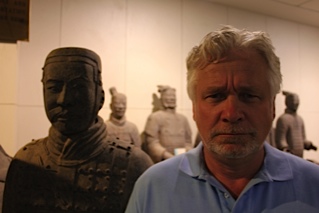
Each Warrior's face is different - each rank is easily identified by their outfit. The generals had a larger belly - our guide thought I was a general
One can imagine living in this time- the emperor making a great sacrifice for his death, and then the people leaving it alone, letting nature take it over – and today, 2200 years later, it is now the archeological treasure of the millennium, dwarfing King Tut and all of Egypt, and giving a glimpse of what life, and traditions were under the first emperor of China.
Today a national treasure of China, there are many tours to see this national treasure. Below we will recommend one in particular. Our photographs cannot do it justice, but as you see what appear to be small- imagine each of those warriors is larger-than-life size persons, carved to perfection. Much of the color has been lost due to the elements, but each one of these figures was carved to perfection, and finished for the after-life.
Comment:
This is a vast area – and you will do a lot of walking– be ready for that. As you can see the pits alone are huge. On a fast clip from the best place in the parking lot to the entrance is a five minute walk.
A guide is best, and we recommend Clarence Guo, who will walk you through this along with some side trips that will provide an outstanding education into the mind of Qin at the time he built this. His book, “Guide to the Qin Warriors” is a classic study. He can be reached at clarenceguo@yahoo.com or www.taxitour.com. His command of English is excellent, he has given over 3000 tours of the area.

